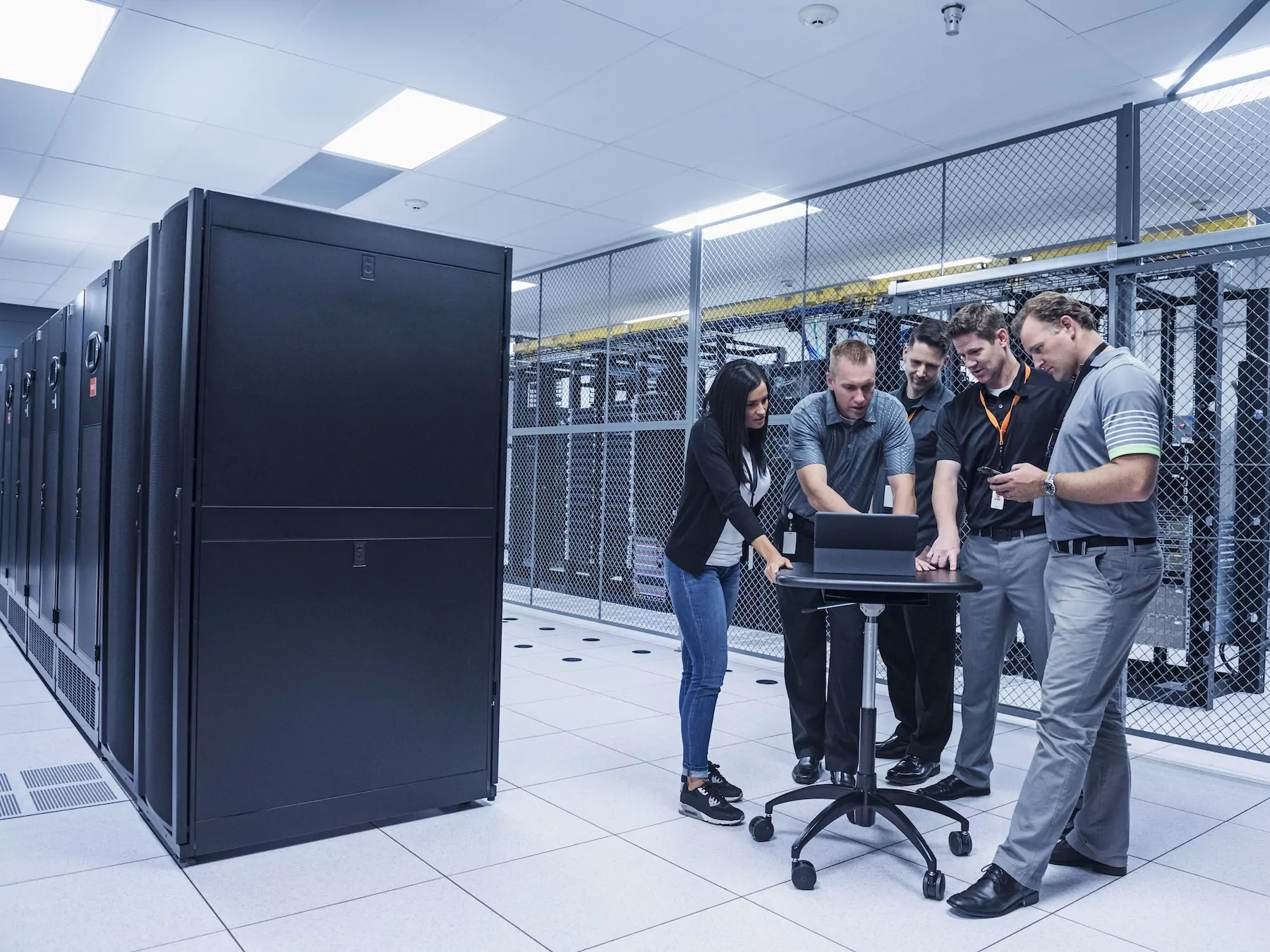
Part one of this series examined the dynamic forces behind data center retransformation. Now, we’ll look at designing the modern data center, exploring the role of advanced technologies, such as AI and containerization, in the quest for resiliency and sustainability.
Strategize and plan for differentiation
As a leader, you need to know where you want to take the business—understanding the trajectory of your organization is nonnegotiable. However, your perspective must be grounded in reality; meaning, you must understand the limitations of your current environment:
- Where does it currently fall short?
- Where have you already identified room for improvement?
- Where can you make meaningful changes?
The answers to these questions can help guide your transformation plan with achievable goals. Changes will likely come through outdated, disjointed technology systems and inefficient, costly processes.
It’s also important to clearly define the role of new advanced technologies in your new environment. AI and containerization are not just buzzwords. They are powerful tools and methods that can help you drive efficiency, agility and resiliency throughout the data center and into everything the business does through digital means.
- AI offers insights and the ability to automate capabilities intelligently.
- More than half of surveyed organizations seek to increase value and revenue through the adoption of generative AI.
- Containerization gives you greater flexibility and growth potential in deploying applications in any hybrid cloud environment that you can envision (and need).
- Gartner predicts that 15% of on-premises production workloads will run in containers by 2026.
Don’t just keep pace with these advancements in technology. Use them and build advanced data-driven processes around them to enable your entire organization to create a distinct, competitive edge.
When you have your objectives and mission clearly defined, you can develop a strategic plan that incorporates advanced technologies, processes—and even partner services—to achieve the outcomes you’ve outlined. This plan should not just solely address the immediate needs but should also be flexible and adaptable to overcome future challenges and use future opportunities. It should also include resiliency and sustainability as core tenants to make sure you can keep growing and transforming for years to come.
Use data and automated precision to produce results
What is automated precision? When you can integrate data, tools and processes to manage and optimize various aspects of a data center, automated precision becomes about harnessing technology to run operations with:
- High accuracy
- Minimal intervention
- Consistent performance
- Predictable outcomes
The global data center automation market was valued at $7.6 billion in 2022. It is expected to reach $20.9 billion by 2030.
Automation will play a pivotal role in transforming the data center, where scale and complexity will outpace the ability of humans to keep everything running smoothly. For you as a business leader, this means pivoting from manual methods to a more streamlined, technology-driven and data-enabled approach.
AI is a critical component in this advancement toward automated precision. Able to analyze large data sets, predict trends and make informed decisions, AI’s role will be to transform mere automation into intelligent operation. 34% of surveyed organizations plan to invest the most in AI and machine learning (ML) over the year.
When you apply AI-enabled automated precision to your data center, you can:
- Handle repetitive, time-consuming tasks with unmatched speed and accuracy
- Free up human resources for more strategic initiatives that can’t be automated
- Identify anomalies swiftly and predict failures before they occur
- Intelligently distribute resources based on real-time demand
- Detect and mitigate threats more effectively compared to traditional methods
- Optimize power usage and reduce waste in alignment with your sustainability goals
Chart a course for resilience and sustainability
The evolution of the data center helps position your organization at the forefront of technological advancement and at the heart of sustainable business practices. Adopting a modern data center that embraces AI, edge computing and containerization can help ensure that your organization will emerge as a dynamic, efficient and environmentally conscious business.
IBM® and VMware can help you design the data center of the future—one that uses automation, hyperconvergence and cloud technologies to support high performance, reliability and sustainability. With offerings for security, compliance, analytics and containerization, IBM and VMware can ensure that your modern data center meets your business goals
Learn more about IBM’s cloud migration consultingWas this article helpful?
YesNo
IBM Newsletters
Get our newsletters and topic updates that deliver the latest thought leadership and insights on emerging trends.Subscribe now More newsletters
- SEO Powered Content & PR Distribution. Get Amplified Today.
- PlatoData.Network Vertical Generative Ai. Empower Yourself. Access Here.
- PlatoAiStream. Web3 Intelligence. Knowledge Amplified. Access Here.
- PlatoESG. Carbon, CleanTech, Energy, Environment, Solar, Waste Management. Access Here.
- PlatoHealth. Biotech and Clinical Trials Intelligence. Access Here.
- Source: https://www.ibm.com/blog/the-blueprint-for-a-modern-data-center/
- :is
- :not
- :where
- $UP
- 1
- 15%
- 1800
- 2022
- 2023
- 2024
- 2030
- 22
- 24
- 29
- 30
- 300
- 31
- 39
- 40
- 400
- 43
- 7
- 9
- a
- ability
- Able
- About
- achievable
- Achieve
- across
- address
- adhere
- Adopting
- Adoption
- advanced
- advancement
- advancements
- Advertising
- agile
- ahead
- AI
- alignment
- All
- already
- also
- amp
- an
- analysis
- analytics
- analyze
- and
- answers
- any
- applications
- Apply
- approach
- ARE
- arising
- around
- article
- AS
- aspects
- At
- AUGUST
- author
- automate
- Automated
- Automation
- avoid
- back
- based
- BE
- becomes
- before
- behind
- Billion
- Blog
- blogs
- Blue
- blueprint
- build
- business
- business development
- business operations
- business practices
- but
- button
- by
- CAN
- capabilities
- carbon
- card
- Cards
- CAT
- catalysts
- Category
- Center
- Centers
- centralized
- certain
- challenges
- Changes
- check
- circles
- CIS
- class
- clearly
- Cloud
- collaborate
- collaboration
- collection
- color
- come
- compared
- competitive
- complex
- complexity
- compliance
- component
- computing
- Confirm
- conscious
- Consequences
- Container
- Containers
- continue
- control
- Core
- cost-effective
- costly
- course
- create
- critical
- crucial
- CSS
- Current
- Currently
- custom
- customer
- data
- Data Center
- data centers
- data management
- data quality
- data sets
- data storage
- data-driven
- datasets
- Date
- decentralize
- Decision Making
- decisions
- Default
- define
- defined
- definitions
- deliver
- Demand
- deploying
- description
- Design
- designed
- designing
- develop
- Development
- difficult
- digital
- Director
- discipline
- distinct
- distribute
- diversify
- does
- dramatic
- drive
- driven
- driving
- dynamic
- Edge
- edge computing
- Effective
- effectively
- efficiency
- efficient
- Embraces
- emerge
- emerging
- enable
- ensure
- Enter
- Entire
- Environment
- environmentally
- envision
- Errors
- especially
- Ether (ETH)
- Even
- everything
- evolution
- example
- Exit
- expected
- Exploring
- facilities
- failures
- Fall
- false
- Flexibility
- flexible
- Focus
- focuses
- follow
- following
- fonts
- For
- Forces
- forefront
- from
- future
- Gartner
- generative
- Generative AI
- generator
- get
- gives
- Global
- Goals
- greater
- Grid
- grounded
- Growing
- Growth
- growth potential
- guide
- Half
- Hardware
- Harnessing
- Have
- Heading
- Heart
- heavily
- height
- help
- helpful
- helps
- High
- high-quality
- However
- http
- HTTPS
- human
- Human Resources
- Humans
- Hybrid
- hybrid cloud
- IBM
- ICO
- ICON
- identified
- image
- immediate
- implement
- important
- improvement
- improving
- in
- include
- inconsistencies
- incorporates
- Increase
- increased
- index
- inefficient
- informed
- initially
- initiatives
- insights
- integrate
- integration
- Intelligent
- into
- Invest
- involves
- IT
- January
- January 24
- jpg
- just
- Keep
- Key
- Know
- landscape
- laptop
- large
- latest
- leader
- Leadership
- learning
- likely
- limitations
- local
- locale
- Look
- looking
- machine
- machine learning
- make
- Making
- manage
- management
- manual
- Market
- massive
- max-width
- McKinsey
- mean
- meaning
- meaningful
- means
- Meet
- Meets
- mere
- methods
- migration
- min
- minutes
- Mission
- Mitigate
- ML
- Mobile
- Modern
- modernize
- more
- most
- must
- Navigation
- Need
- needs
- negative
- New
- New technologies
- Newsletters
- nothing
- now
- objective
- objectives
- of
- off
- Offerings
- Offers
- on
- ONE
- Operations
- opportunities
- Optimize
- optimized
- or
- orchestration
- organization
- organizations
- our
- outcomes
- outlined
- over
- Overcome
- own
- Pace
- page
- part
- partner
- performance
- person
- perspective
- PHP
- pivotal
- plan
- platform
- Platforms
- plato
- Plato Data Intelligence
- PlatoData
- Play
- plugin
- policy
- position
- Post
- potential
- power
- powerful
- practice
- practices
- Precision
- predict
- Predicts
- prefer
- pressure
- primary
- processes
- processing
- produce
- Production
- promising
- providing
- quality
- quest
- Questions
- rapid
- reach
- Reading
- real-time
- Reality
- reduce
- reduce waste
- reliability
- rely
- repetitive
- Requirements
- resilience
- Resources
- responsive
- restore
- revenue
- robots
- Role
- Room
- Run
- running
- Savings
- Scale
- Screen
- scripts
- security
- Seek
- seismic
- sensitive
- seo
- server
- service
- Services
- Sets
- Share
- shift
- Short
- should
- significant
- simplify
- site
- small
- smoothly
- Software
- solely
- Solutions
- specific
- speed
- Sponsored
- squares
- stages
- standards
- start
- storage
- Strategic
- Strategy
- streamline
- streamlined
- subscribe
- such
- support
- sure
- surveyed
- Sustainability
- sustainable
- SVG
- swiftly
- Systems
- Take
- tasks
- team
- teams
- technological
- Technologies
- Technology
- tertiary
- Testing
- than
- thanks
- that
- The
- their
- Them
- theme
- There.
- These
- they
- this
- though?
- thought
- thought leadership
- threats
- Through
- throughout
- time
- time-consuming
- times
- Title
- to
- tools
- top
- topic
- toward
- traditional
- trajectory
- Transformation
- transforming
- Trends
- type
- undergoing
- understand
- unified
- unmatched
- Updates
- URL
- Usage
- use
- uses
- validation
- value
- valued
- various
- Verification
- vmware
- W
- want
- was
- Waste
- WELL
- were
- when
- why
- will
- with
- WordPress
- working
- world
- written
- year
- years
- you
- Your
- zephyrnet
















